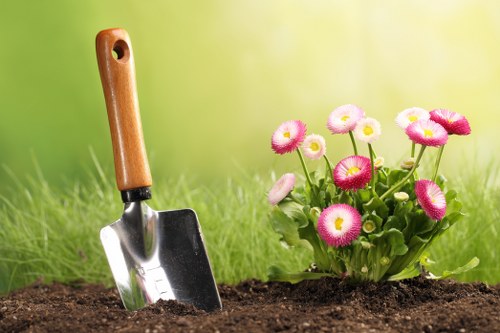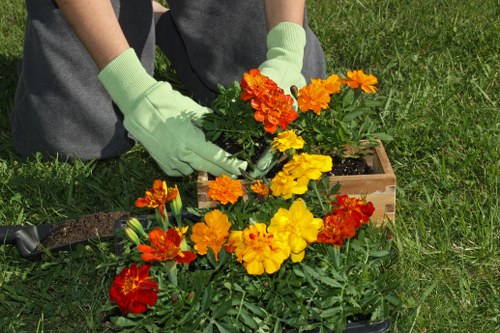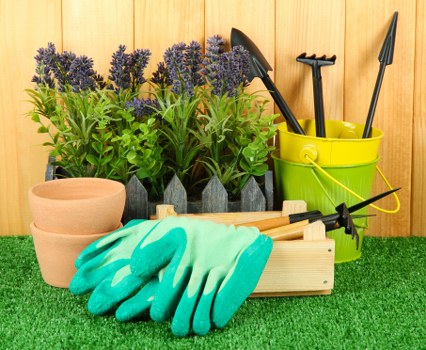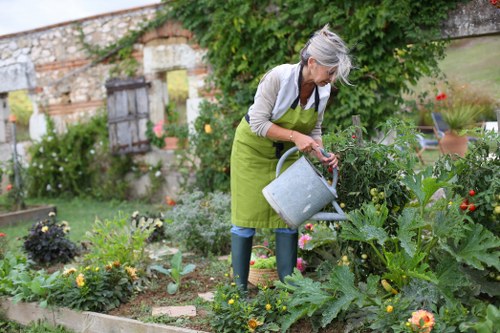Transform Your Outdoor Space with Expert Landscape Gardening Services
Introduction to Landscape Gardening

Landscape gardening is an essential aspect of creating aesthetically pleasing and functional outdoor spaces. Whether you have a sprawling backyard or a compact patio, professional garden services can help transform your vision into reality.
By integrating various elements like plants, structures, and water features, landscape gardening not only enhances the beauty of your property but also adds value and functionality.
In this article, we'll explore the key aspects of landscape gardening within garden services, providing insights into how you can achieve a harmonious and sustainable outdoor environment.
Planning Your Landscape

Successful landscape gardening begins with meticulous planning. This involves assessing your outdoor space, understanding your preferences, and considering environmental factors.
Professional garden services work closely with clients to design layouts that maximize space, sunlight, and soil conditions, ensuring that the chosen plants thrive.
Key steps in the planning process include:
- Site Analysis: Evaluating the existing conditions of your garden.
- Design Concept: Creating a blueprint that aligns with your aesthetic and functional goals.
- Plant Selection: Choosing appropriate flora that suits the climate and soil.
Essential Elements of Landscape Gardening

Landscape gardening incorporates various elements that work together to create a cohesive and inviting outdoor space.
These elements include:
- Plants: Trees, shrubs, flowers, and groundcovers that provide color, texture, and structure.
- Hardscaping: Patios, walkways, fences, and other non-plant features that add functionality and style.
- Water Features: Ponds, fountains, and streams that introduce the soothing sounds of water.
- Lighting: Outdoor lighting that enhances beauty and ensures safety during nighttime.
Balancing these elements is crucial for achieving a well-rounded landscape.
Choosing the Right Plants

Plant selection is a pivotal part of landscape gardening. The right plants can thrive in your specific environment while contributing to the overall design.
Consider the following factors when selecting plants:
- Climate: Choose plants that are well-suited to your local weather conditions.
- Soil Type: Ensure the soil supports the needs of your chosen flora.
- Sunlight: Match plants to areas with appropriate light exposure.
- Maintenance: Select plants that fit your desired level of upkeep.
Professional gardeners can recommend species that not only look great but are also sustainable and low-maintenance.
Incorporating Sustainable Practices

Sustainability is increasingly important in landscape gardening. Implementing eco-friendly practices can reduce environmental impact and promote a healthier ecosystem.
Key sustainable practices include:
- Water Conservation: Utilizing drip irrigation and native plants to minimize water usage.
- Organic Gardening: Avoiding chemical fertilizers and pesticides in favor of natural alternatives.
- Composting: Recycling garden waste to enrich soil health.
- Biodiversity: Creating habitats that support local wildlife and beneficial insects.
Adopting these practices ensures your garden remains vibrant and resilient for years to come.
Maintenance Services

Regular maintenance is essential to keep your landscape garden looking its best. Professional garden services offer comprehensive maintenance plans tailored to your needs.
Services typically include:
- Pruning and Trimming: Keeping plants healthy and properly shaped.
- Lawn Care: Mowing, fertilizing, and pest control to maintain a lush lawn.
- Weeding: Removing unwanted plants to prevent competition for resources.
- Seasonal Clean-Up: Preparing your garden for different seasons with appropriate care.
Consistent maintenance not only preserves the beauty of your garden but also promotes the longevity of your plants and structures.
Enhancing Your Garden with Hardscaping
Patios and Walkways
Hardscaping features like patios and walkways provide both functionality and aesthetic appeal to your landscape.
A well-designed patio offers a space for outdoor entertaining, dining, or relaxation, while walkways guide visitors through your garden seamlessly.
Materials commonly used include brick, stone, concrete, and pavers, each offering different textures and durability.
Fences and Retaining Walls
Fences and retaining walls serve practical purposes while adding structure and definition to your garden.
They provide privacy, security, and can help manage slopes or erosion. Moreover, they contribute to the overall aesthetic by complementing the garden's design.
Choosing the right materials and styles ensures these features enhance rather than detract from your landscape.
Water Features
Water features are a popular addition to landscape gardens, offering a focal point and soothing ambiance.
Options include ponds, fountains, waterfalls, and streams. They not only enhance beauty but also attract wildlife and help in cooling the surrounding area.
Proper installation and maintenance are crucial to ensure longevity and functionality of water elements.
Lighting Your Landscape

Outdoor lighting plays a vital role in landscape gardening, highlighting key features and ensuring safety during nighttime.
There are various types of garden lighting:
- Path Lighting: Illuminates walkways and prevents accidents.
- Accent Lighting: Highlights architectural features or specific plants.
- Ambient Lighting: Creates a warm and inviting atmosphere for gatherings.
- Solar Lighting: Eco-friendly options that reduce energy consumption.
Strategically placed lighting can transform your garden, making it enjoyable day and night.
Seasonal Considerations

Each season presents unique challenges and opportunities for your landscape garden. Adapting your gardening practices ensures year-round beauty and health of your outdoor space.
Key seasonal tasks include:
- Spring: Planting new growth, mulching, and preparing beds.
- Summer: Watering, pruning, and pest control.
- Autumn: Leaf removal, preparing plants for winter, and planting bulbs.
- Winter: Protecting plants from frost and planning for the next growing season.
Understanding seasonal needs helps maintain a vibrant and resilient garden throughout the year.
Professional vs. DIY Landscape Gardening
[p]Choosing between hiring professional garden services and undertaking DIY landscape gardening depends on various factors.While DIY projects can be fulfilling and cost-effective, professional services offer expertise, efficiency, and high-quality results.
Benefits of hiring professionals include:
- Expert Knowledge: Professionals understand plant biology, soil conditions, and design principles.
- Time Savings: Saving you time and effort with efficient project management.
- Access to Resources: Utilizing high-quality materials and specialized equipment.
- Ongoing Support: Providing maintenance and troubleshooting for long-term garden health.
For those seeking a beautifully crafted and sustainable landscape, professional garden services are a worthwhile investment.
Cost Considerations

Investing in landscape gardening can vary in cost based on the scope of the project, materials used, and labor involved.
Factors influencing costs include:
- Design Complexity: Intricate designs with multiple elements typically cost more.
- Material Selection: High-end materials like natural stone are pricier than alternatives.
- Size of the Area: Larger gardens require more resources and time.
- Customization: Personalized features tailored to your preferences can increase costs.
It's essential to set a budget and discuss it with your landscape gardener to achieve the best results within your financial plan.
Choosing the Right Garden Service Provider

Selecting a reputable and skilled garden service provider is crucial for the success of your landscape gardening project.
Consider the following when choosing a provider:
- Experience: Look for companies with a proven track record in landscape gardening.
- Portfolio: Review their past projects to gauge their style and quality.
- Client Reviews: Feedback from previous clients can provide insights into their reliability and performance.
- Services Offered: Ensure they provide the specific services you need, from design to maintenance.
Taking the time to research and select the right provider ensures your garden project is in capable hands.
Benefits of Professional Landscape Gardening
Engaging professional garden services offers numerous advantages for your outdoor space.
Key benefits include:
- Enhanced Aesthetics: Creating visually appealing and harmonious garden designs.
- Increased Property Value: Well-maintained landscapes can boost the market value of your property.
- Environmental Impact: Promoting sustainable practices that benefit the ecosystem.
- Personal Well-being: Providing a serene and beautiful environment for relaxation and enjoyment.
These benefits contribute to a more enjoyable and valuable outdoor living experience.
Latest Trends in Landscape Gardening

Staying updated with the latest trends in landscape gardening can inspire new ideas and keep your garden modern and appealing.
Current trends include:
- Vertical Gardens: Maximizing space with plant growth on walls and structures.
- Sustainable Landscaping: Emphasizing eco-friendly materials and practices.
- Smart Gardens: Incorporating technology for automated irrigation and lighting.
- Edible Gardens: Growing herbs, vegetables, and fruits within the landscape.
Integrating these trends can make your garden not only beautiful but also functional and innovative.
Final Thoughts on Landscape Gardening
Landscape gardening is a transformative process that enhances the beauty, functionality, and value of your outdoor spaces.
By partnering with professional garden services, you can ensure a well-designed, sustainable, and maintained garden that reflects your personal style and meets your specific needs.
Ready to transform your garden? Contact us today to schedule a consultation and begin your journey to a stunning outdoor oasis.